Influence of Aggregate Composition on the Properties of Recycled Concrete and Improving Performance Using Special Additives
Abstract
1. Introduction
- Conduct an extensive assessment of the mechanical properties of RAC, focusing on strength development across various substitution levels and curing regimes;
- Investigate the role of pre-soaking treatments and advanced admixtures in modulating setting time, ensuring consistency across different recycled aggregate sources;
- Examine the permeability characteristics of RAC through water absorption tests;
2. Materials and Methods
2.1. Raw Materials
2.1.1. Recycled Concrete Aggregates (RCA)
- R0. ‘reinforced pool’: reinforced concrete pool demolition material directly from the demolition site (estimated strength class: C25/30);
- R1. ‘Precast’: a reclaimed byproduct of precast slab panels scrapped during pre-casting plant product testing due to geometric nonconformity (estimated strength class: C40/50);
- R2. ‘Pure concrete demolition’: demolition waste from an industrial reinforced concrete frame building from an unknown location sourced from a recycling site;
- R3. ‘Mixed demolition waste’: mixed demolition waste (mainly concrete waste and other brick and ceramic content) from unknown sources sourced from a recycling site.
2.1.2. Natural Aggregates, Graded Sand, and Gravel
2.1.3. Cement
2.1.4. Chemical Admixtures
2.1.5. Mixing Water
2.2. Mix Designs
2.3. Concrete Testing Methods
- (1)
- Aggregates:
- (2)
- Concrete mixing procedure and testing methods:
- (3)
- Hardened concrete properties and testing methods:
3. Results and Discussions
3.1. Recycled Aggregates Testing
3.2. Fresh Concrete Properties and Testing Methods: Initial Setting Time
3.3. Tests on Fresh Concrete: Consistency, Air Content, and Density
Determination of Fresh Concrete Density According to EN 12350-6:2019 [55] and Air Content According to EN 12350-7:2019 [56]
3.4. Tests on Hardened Concrete [57,58]
3.4.1. Compressive Strength
3.4.2. Water Resistance Test
4. Conclusions
- (i)
- Laboratory tests conducted on crushed recycled aggregates confirmed that concrete incorporating these aggregates met the compressive strength and water resistance standards despite the recycled aggregates themselves not meeting all standard requirements. These findings suggest that recycled aggregates can serve as a feasible substitute for natural coarse aggregates in various concrete compositions. However, it is crucial to emphasize that each batch of crushed aggregate is unique and requires thorough testing and evaluation, including trial mixing, for suitability in specific applications;
- (ii)
- According to the experimental results, the concrete mixtures with 15 and 30% recycled aggregates presented a higher 28-day compressive strength compared to the conventional reference mixes with gravel aggregates. The addition of the recycled aggregate in a saturated, surface-dried state increased the 28-day compressive strength of the concrete, and a further increase was observed when the recycled aggregate ratio was increased from 15% to 30%. This phenomenon can be attributed to the favorable water–cement ratio. As the recycled aggregate absorbs moisture from the concrete, the overall water–cement ratio decreases, resulting in reduced capillary pore formation;
- (iii)
- Experiments demonstrated that the loss of initial setting time could not be compensated for by increasing the amount of mixing water when the recycled aggregate was added to the mixture in a dehydrated state. For mixtures with high porosity and high substitution rates, if the initial water uptake is not eliminated (adsorption inhibition) upon the first water contact, the subsequent addition of the superplasticizer does not solve the consistency and shelf-life problems. Additionally, the varying composition of the crushed recycled aggregates could influence the effectiveness of both the mixing water and the additive;
- (iv)
- The results of the tests demonstrated that all of the mixtures met the maximum water penetration requirement for environmental class XV2 (H) according to the Hungarian standard MSZ 4798:2016/2M [53]. This standard specifies a maximum permissible individual depth of water penetration of 35 mm. It should be noted that, while the relevant standard does not recommend the use of recycled aggregate in waterproofing structures, our research suggests that further testing and potential revisions to regulations may be warranted.
Author Contributions
Funding
Institutional Review Board Statement
Informed Consent Statement
Data Availability Statement
Acknowledgments
Conflicts of Interest
References
- Chan, C.Y.; Fong, W.F.K. Management of Construction and Demolition Materials and Development of Recycling Facility in Hong Kong. In Proceedings of the International Conference on Innovation and Sustainable Development of Civil Engineering in the 21st Century, Beijing, China, July 2002. [Google Scholar]
- Fong, W.; Yeung, J. Hong Kong Experience of Using Recycled Aggregates from Construction and Demolition Materials in Ready Mix Concrete. In Proceedings of the International Workshop on Sustainable Development and Concrete Technology, Beijing, China, 20–21 May 2002. [Google Scholar]
- Lim, W.F. Evaluation of the Use of Recycled Concrete Aggregate in Structural Concrete. Master’s Thesis, Nanyang Technological University, Singapore, 2011. [Google Scholar] [CrossRef]
- Naik, M.; Ramakrishnaiah, A. An Experimental Study on Utilization of Demolished Concrete Waste for New Construction. J. Emerg. Technol. Innov. Res. 2018, 5, 1–6. [Google Scholar]
- Ismail, S.; Ramli, M. Mechanical Strength and Drying Shrinkage Properties of Concrete Containing Treated Coarse Recycled Concrete Aggregates. Constr. Build. Mater. 2014, 68, 726–739. [Google Scholar] [CrossRef]
- Ismail, S.; Ramli, M. Effect of Different Moisture States of Surface-Treated Recycled Concrete Aggregate on Properties of Fresh and Hardened Concrete. Int. J. Mater. Metall. Eng. 2018, 8, 65–71. [Google Scholar]
- Ahmed, H.; Tiznobaik, M.; Huda, S.; Islam, M.; Alam, M.S. Recycled Aggregate Concrete from Large-Scale Production to Sustainable Field Application. Constr. Build. Mater. 2020, 262, 119979. [Google Scholar] [CrossRef]
- Zhang, J.; Zhu, X.; Zhou, M.; Huang, X. Experimental Study on Preparation and Characteristics of Concrete Modified by Construction Waste. Appl. Sci. 2024, 14, 1974. [Google Scholar] [CrossRef]
- Ju, X.; Wu, L.; Liu, M.; Guan, L.; Jiang, H.; Zhang, W. Influence of Material Factors on Improving the Properties of a Recycled Coarse Aggregate and its Concrete Under Co2-Curing Treatment. Materials 2024, 17, 706. [Google Scholar] [CrossRef]
- Hoffmann Sampaio, C.; Cazacliu, B.G.; Ambrós, W.M.; Kronbauer, M.A.; Tubino, R.M.C.; Dal Molin, D.C.C.; Oliva Moncunill, J.; Miltzarek, G.L.; Waskow, R.P.; dos Santos, V.L.G.; et al. Characterization of Demolished Concretes with Three Different Strengths for Recycling as Coarse Aggregate. Minerals 2021, 11, 803. [Google Scholar] [CrossRef]
- Robalo, K.; Costa, H.; do Carmo, R.; Júlio, E. Experimental Development of Low Cement Content and Recycled Construction and Demolition Waste Aggregates Concrete. Constr. Build. Mater. 2021, 273, 121680. [Google Scholar] [CrossRef]
- Aili, A.; Maruyama, I. Review of Several Experimental Methods for Characterization of Micro- and Nano-Scale Pores in Cement-Based Material. Int. J. Concr. Struct. Mater. 2020, 14, 55. [Google Scholar] [CrossRef]
- García-González, J.; Rodríguez-Robles, D.; Juan-Valdes, A.; Pozo, J.; Guerra-Romero, M. Pre-Saturation Technique of the Recycled Aggregates: Solution to the Water Absorption Drawback in the Recycled Concrete Manufacture. Materials 2014, 7, 6224–6236. [Google Scholar] [CrossRef] [PubMed]
- Wang, F.; Yu, Y.; Zhao, X.-Y.; Xu, J.; Xie, T.; Deresa, S. Performance Evaluation of Reinforced Recycled Aggregate Concrete Columns under Cyclic Loadings. Appl. Sci. 2019, 9, 1460. [Google Scholar] [CrossRef]
- Badraddin, A.; Rahman, R.A.; Almutairi, S.; Esa, M. Main Challenges to Concrete Recycling in Practice. Sustainability 2021, 13, 11077. [Google Scholar] [CrossRef]
- Ahmad, S.I.; Hossain, M. Water Permeability Characteristics of Normal Strength Concrete Made from Crushed Clay Bricks as Coarse Aggregate. Adv. Mater. Sci. Eng. 2017, 2017, 7279138. [Google Scholar] [CrossRef]
- Skocek, J.; Ouzia, A.; Serrano, E.; Pato, N. Recycled Sand and Aggregates for Structural Concrete: Toward the Industrial Production of High-Quality Recycled Materials with Low Water Absorption. Sustainability 2024, 16, 814. [Google Scholar] [CrossRef]
- Al-Kheetan, M.; Jweihan, Y.; Rabi, M.; Ghaffar, S. Durability Enhancement of Concrete with Recycled Concrete Aggregate: The Role of Nano-ZnO. Buildings 2024, 14, 353. [Google Scholar] [CrossRef]
- Zhong, C.; Lu, W.; Mao, W.; Xin, S.; Chen, J.; Zhou, J.; Shi, C. Research on Capillary Water Absorption Characteristics of Modified Recycled Concrete under Different Freeze–Thaw Environments. Appl. Sci. 2024, 14, 1247. [Google Scholar] [CrossRef]
- The Role of the Construction Materials Industry in the Circular Economy; Publication of Hungarian Cement Concrete and Lime Association: Budapest, Hungary, 2020.
- Li, X. Recycling and Reuse of Waste Concrete in China: Part I. Material Behaviour of Recycled Aggregate Concrete. Resour. Conserv. Recycl. 2008, 53, 36–44. [Google Scholar] [CrossRef]
- Li, X. Recycling and Reuse of Waste Concrete in China: Part II. Structural Behaviour of Recycled Aggregate Concrete and Engineering Applications. Resour. Conserv. Recycl. 2009, 53, 107–112. [Google Scholar] [CrossRef]
- Meissner, M. Biegetragverhalten von Stahlbetonbauteilen mit rezyklierten Zuschlägen. In DafStb Heft 505; Vertrieb durch Beuth Verlag GmbH Berlin: Berlin, Germany, 2000. [Google Scholar]
- Zilch, K.; Roos, F. Betonkennwerte für die Bemessung und das Verbundverhalten von Beton mit rezykliertem Zuschlag. In DafStb Heft 507; Vertrieb durch Beuth Verlag GmbH Berlin: Berlin, Germany, 2000. [Google Scholar]
- Chen, H.; Yen, T.; Chen, K. The Use of Building Rubbles in Concrete and Mortar. J. Chin. Inst. Eng. 2003, 26, 227–236. [Google Scholar] [CrossRef]
- Zhang, Z.; Hu, G.; Mu, X.; Kong, L. From Low Carbon to Carbon Neutrality: A Bibliometric Analysis of the Status, Evolution and Development Trend. J. Environ. Manag. 2022, 322, 116087. [Google Scholar] [CrossRef]
- Revathi, P.; Amirthavalli, R.; Karan, L. Influence of Treatment Methods on the Strength and Performance Characteristics of Recycled Aggregate Concrete. J. Mater. Civ. Eng. 2014, 27, 04014168. [Google Scholar] [CrossRef]
- Kępniak, M.; Łukowski, P. Multicriteria Analysis of Cement Mortar with Recycled Sand. Sustainability 2024, 16, 1773. [Google Scholar] [CrossRef]
- Dacic, A.; Fenyvesi, O.; Abed, M. An Innovative Approach for Evaluating the Quality of Recycled Concrete Aggregate Mixes. Buildings 2024, 14, 471. [Google Scholar] [CrossRef]
- Kashkash, S.; Olivér, C.; Orban, Z. Effect of Moisture Condition and the Composition of Aggregate from Demolition Waste on Strength and Workability Properties of Recycled Concrete. Buildings 2023, 13, 1870. [Google Scholar] [CrossRef]
- Santillan, L.; Zega, C.; Irassar, E. Current Knowledge and Pending Research on Sulfate Resistance of Recycled Aggregate Concrete. Sustainability 2024, 16, 1310. [Google Scholar] [CrossRef]
- Rangel, C.; Amario, M.; Pepe, M.; Martinelli, E.; Toledo Filho, R. Durability of Structural Recycled Aggregate Concrete Subjected to Freeze–Thaw Cycles. Sustainability 2020, 12, 6475. [Google Scholar] [CrossRef]
- Li, H.; Liu, J.; Chu, F.; Zhang, L. Resisrance of 100% Recycled Aggregate Concrete. Buildings 2022, 12, 1467. [Google Scholar] [CrossRef]
- Pico Cortés, C.; Villagrán-Zaccardi, Y. Unraveling the Interplay of Physical-Chemical Factors Impacting the Carbonation Performance of Recycled Aggregate Concrete. Materials 2023, 16, 5692. [Google Scholar] [CrossRef]
- Zhong, C.; Yu, Z.; Zhou, J.; Long, Y.; Tian, P.; Chen, J. Effect of Nano-TiO2 on Capillary Water Absorption of Recycled Aggregate Concrete. Coatings 2022, 12, 1833. [Google Scholar] [CrossRef]
- Yang, S.; Gu, M.; Lin, H.; Gong, Y. Property Improvement of Recycled Coarse Aggregate by Accelerated Carbonation Treatment under Different Curing Conditions. Sustainability 2023, 15, 4908. [Google Scholar] [CrossRef]
- Evangelista, L.; Brito, J. Flexural Behaviour of Reinforced Concrete Beams Made with Fine Recycled Concrete Aggregates. KSCE J. Civ. Eng. 2016, 21, 353–363. [Google Scholar] [CrossRef]
- Pan, G.; Zhan, M.; Fu, M.; Wang, Y.; Lu, X. Effect of CO2 Curing on Demolition Recycled Fine Aggregates Enhanced by Calcium Hydroxide Pre-Soaking. Constr. Build. Mater. 2017, 154, 810–818. [Google Scholar] [CrossRef]
- Guo, H.; Shi, C.; Guan, X.; Zhu, J.; Ding, Y.; Ling, T.C.; Zhang, H.; Wang, Y. Durability of recycled aggregate concrete—A review. Cement Concr. Comp. 2018, 89, 251–259. [Google Scholar] [CrossRef]
- Fang, X.; Xuan, D.; Poon, C.S. Empirical modelling of CO2 uptake by recycled concrete aggregates under accelerated carbonation conditions. Mater. Struct. 2017, 50, 200. [Google Scholar] [CrossRef]
- Zhang, Z.; Liu, X.; Hu, R.; Liang, C.; Zhang, Y.; Ma, Z. Mechanical Behavior of Sustainable Engineered Cementitious Composites with Construction Waste Powder as Binder and Sand Replacement. Constr. Build. Mater. 2023, 404, 133185. [Google Scholar] [CrossRef]
- Momen, R.; Shirzadi Javid, A.A.; Piri, M.; Badiee, A. Modeling Elastic Modulus of Concrete Containing Recycled Aggregates Based on Composite Material Models. Int. J. Civ. Eng. 2023, 21, 1595–1609. [Google Scholar] [CrossRef]
- MSZ EN 933-1:1998; Tests for Geometrical Properties of Aggregates—Part 1: Determination of Particle Size Distribution—Sieving Method. Hungarian Standards Institution: Budapest, Hungary, 1998.
- MSZ EN 197-1:2011; Cement—Part 1: Composition, Specifications, and Conformity Criteria for Common Cements. Hungarian Standards Institution: Budapest, Hungary, 2011.
- MSZ 4798:2016; Aggregates for Concrete. Hungarian Standards Institution: Budapest, Hungary, 2016.
- EN 1097-1:2012; Tests for Mechanical and Physical Properties of Aggregates - Part 1: Determination of the Resistance to Wear (Micro-Deval). European Committee for Standardization: Luxembourg, 2012.
- EN 1097-2:2020; Tests for Mechanical and Physical Properties of Aggregates—Part 2: Methods for Determination of Resistance to Fragmentation (Los Angeles Test). European Committee for Standardization: Luxembourg, 2020.
- EN 1097-6:2022; Tests for Mechanical and Physical Properties of Aggregates – Part 6: Determination of Particle Density and Water Absorption. European Committee for Standardization: Luxembourg, 2022.
- MSZ EN 12350-5:2009; Testing Fresh Concrete—Part 5: Flow Table Test. Hungarian Standards Institution: Budapest, Hungary, 2009.
- EN 12390-3:2019; Testing Hardened Concrete—Part 3: Compressive Strength of Test Specimens. European Committee for Standardization: Luxembourg, 2019.
- EN 12390-8:2019; Testing Hardened Concrete—Part 8: Depth of Penetration of Water Under Pressure. European Committee for Standardization: Luxembourg, 2019.
- EN 12390-2:2019; Testing Hardened Concrete—Part 2: Making and Curing Specimens for Strength Tests. European Committee for Standardization: Luxembourg, 2019.
- MSZ 4798:2016/2M:2018; Concrete. Technical Requirements, Properties, Construction and Conformity and Conditions of Application of EN 206 in Hungary. Hungarian Standards Institution: Budapest, Hungary, 2018.
- EN 206:2013+A2:2021; Concrete – Specification, Performance, Production and Conformity. European Committee for Standardization: Luxembourg, 2021.
- EN 12350-6:2019; Testing Fresh Concrete—Part 6: Density. European Committee for Standardization: Luxembourg, 2019.
- EN 12350-7:2019; Testing Fresh Concrete—Part 7: Air Content—Pressure Methods. European Committee for Standardization: Luxembourg, 2019.
- EN 12390-7:2019; Testing Hardened Concrete—Part 7: Density of Hardened Concrete. European Committee for Standardization: Luxembourg, 2019.
- EN 12390-6:2019; Testing Hardened Concrete—Part 6: Tensile Splitting Strength of Test Specimens. European Committee for Standardization: Luxembourg, 2019.
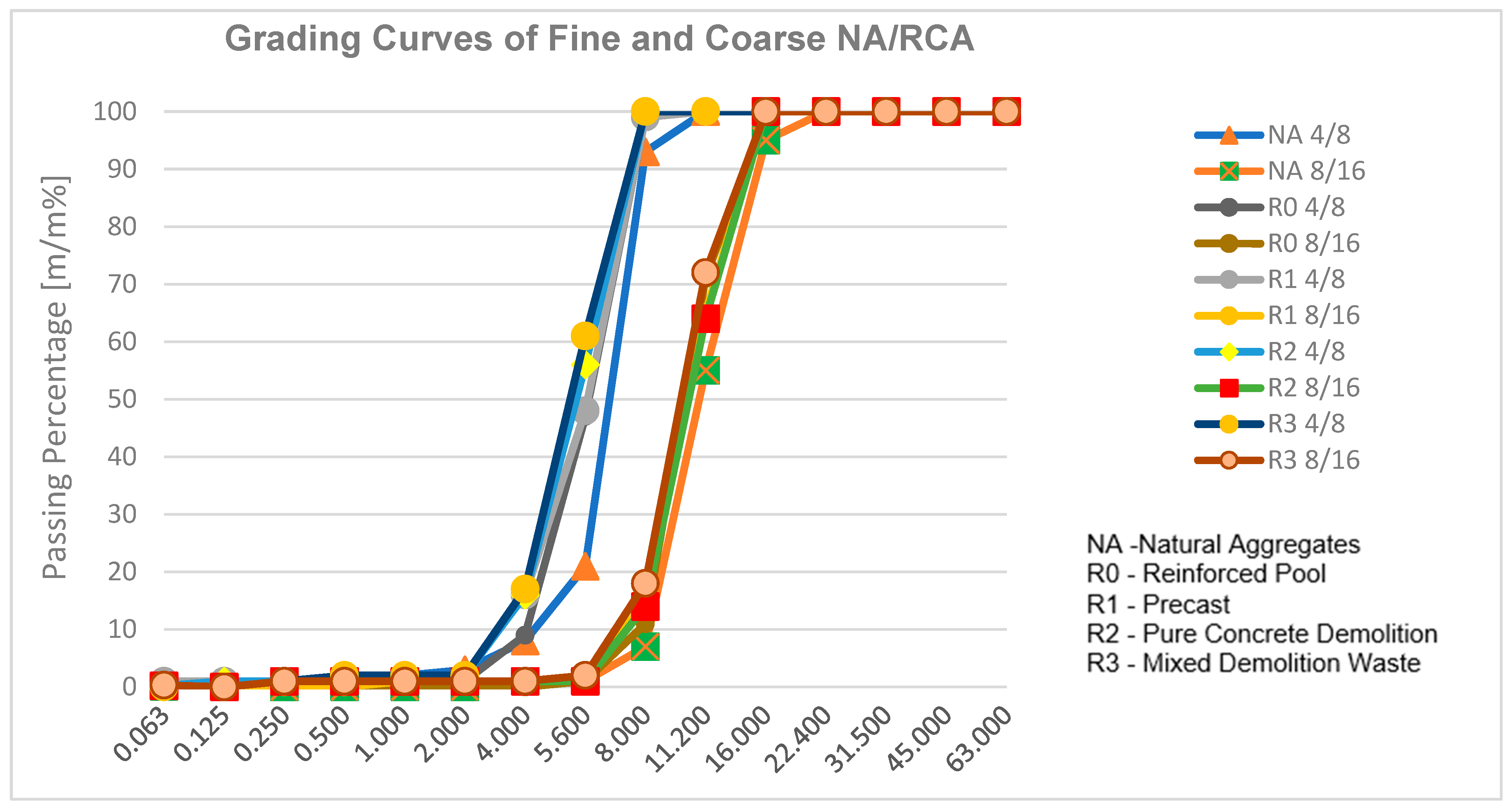
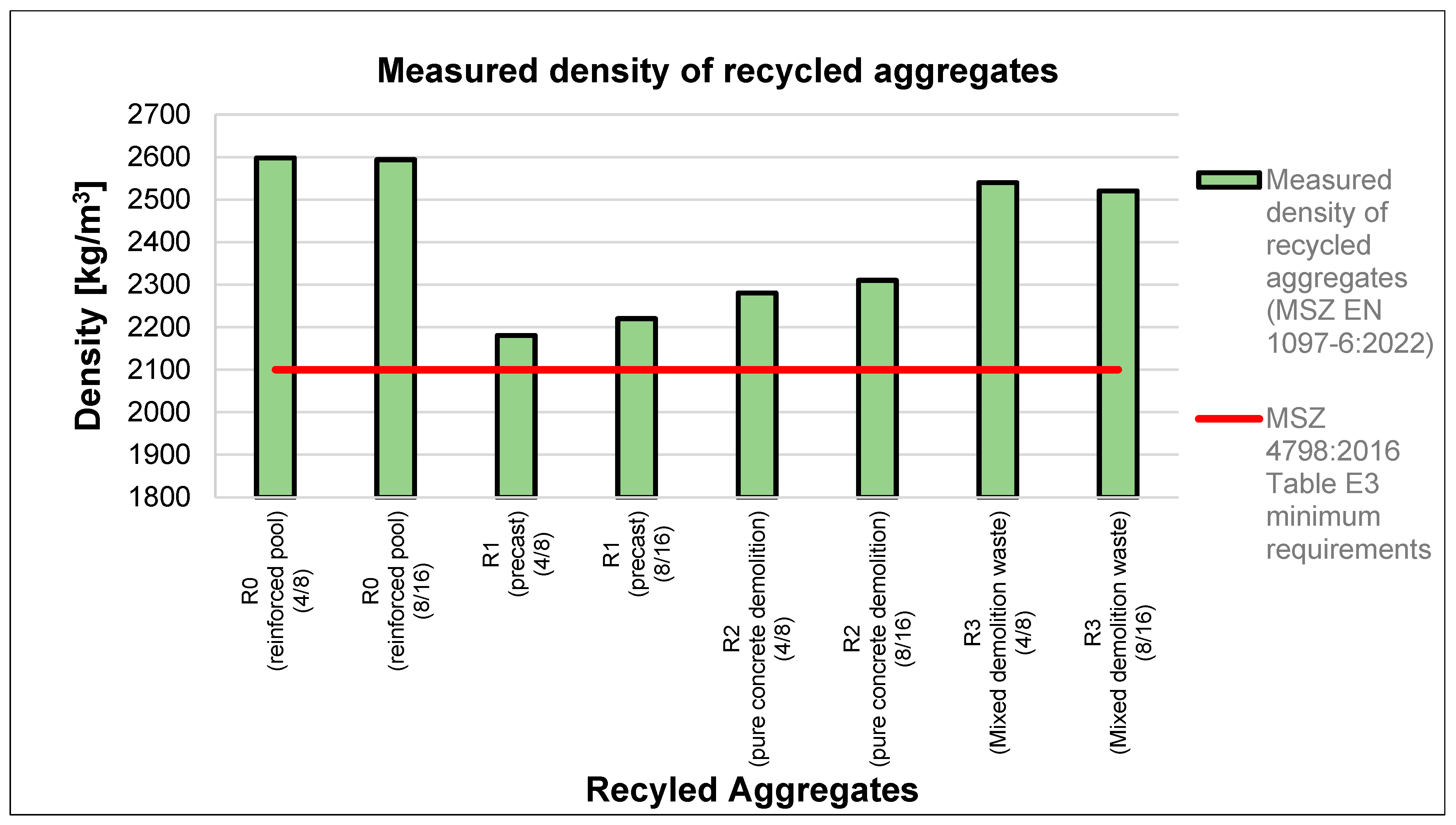
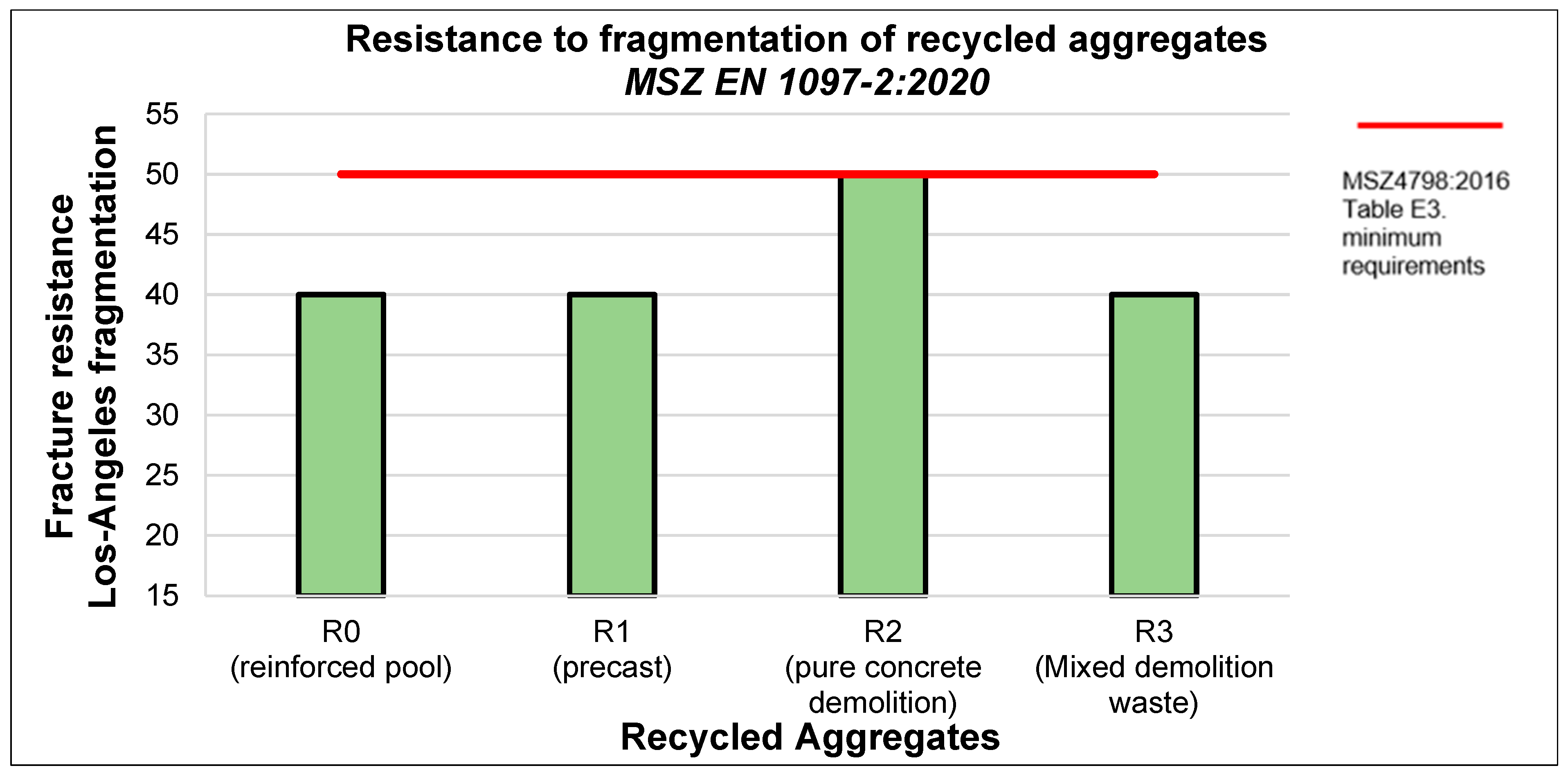
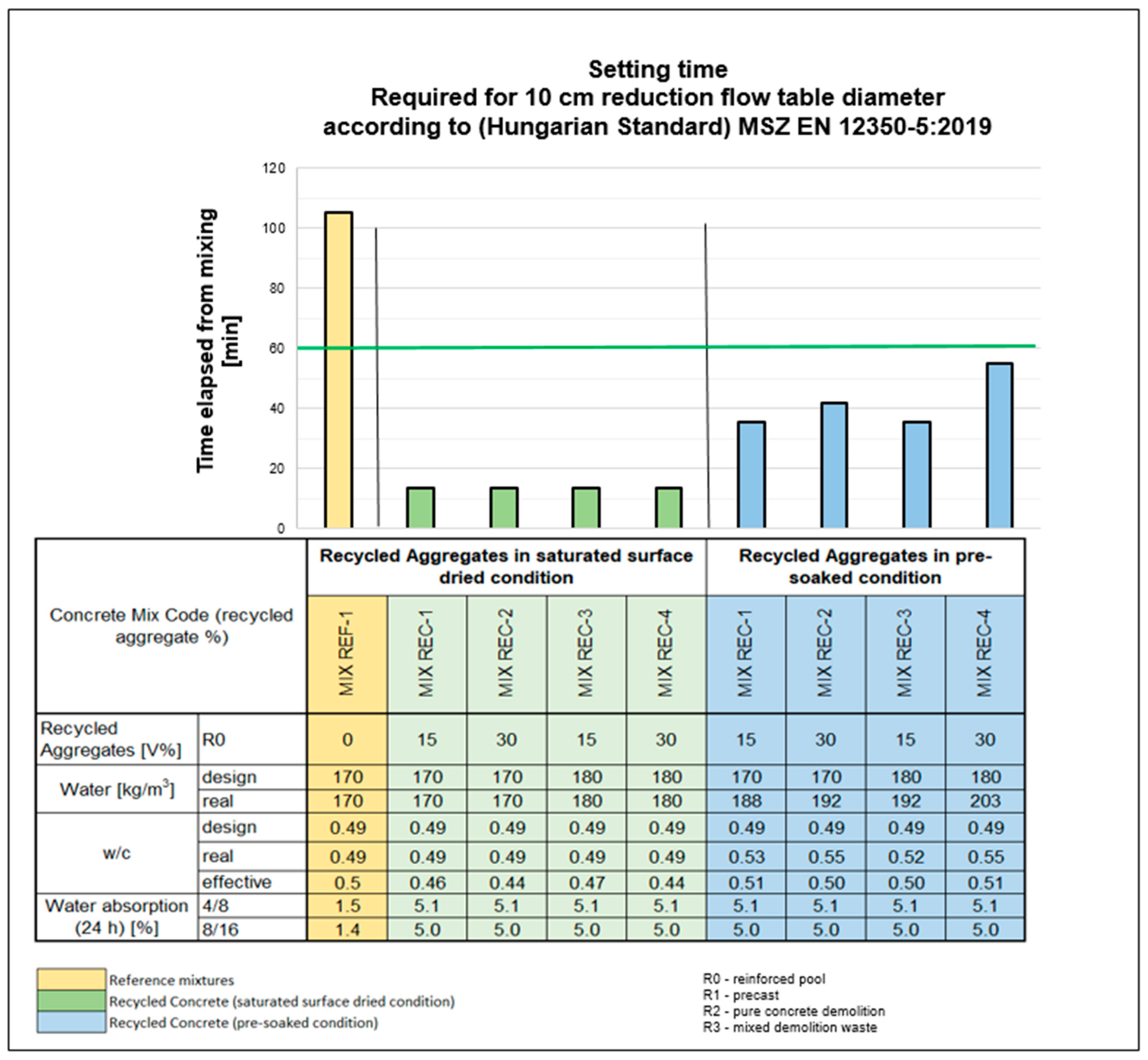

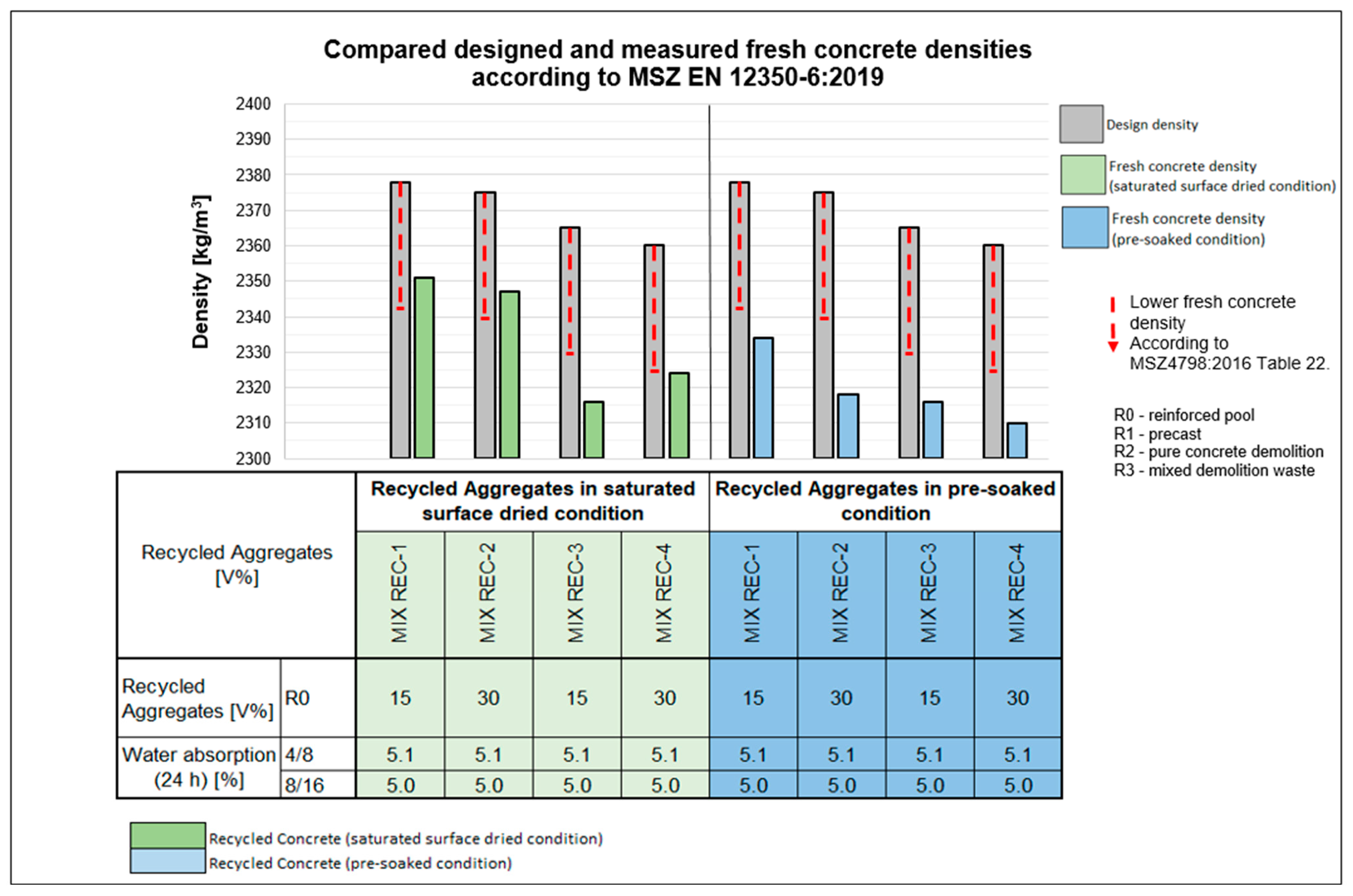
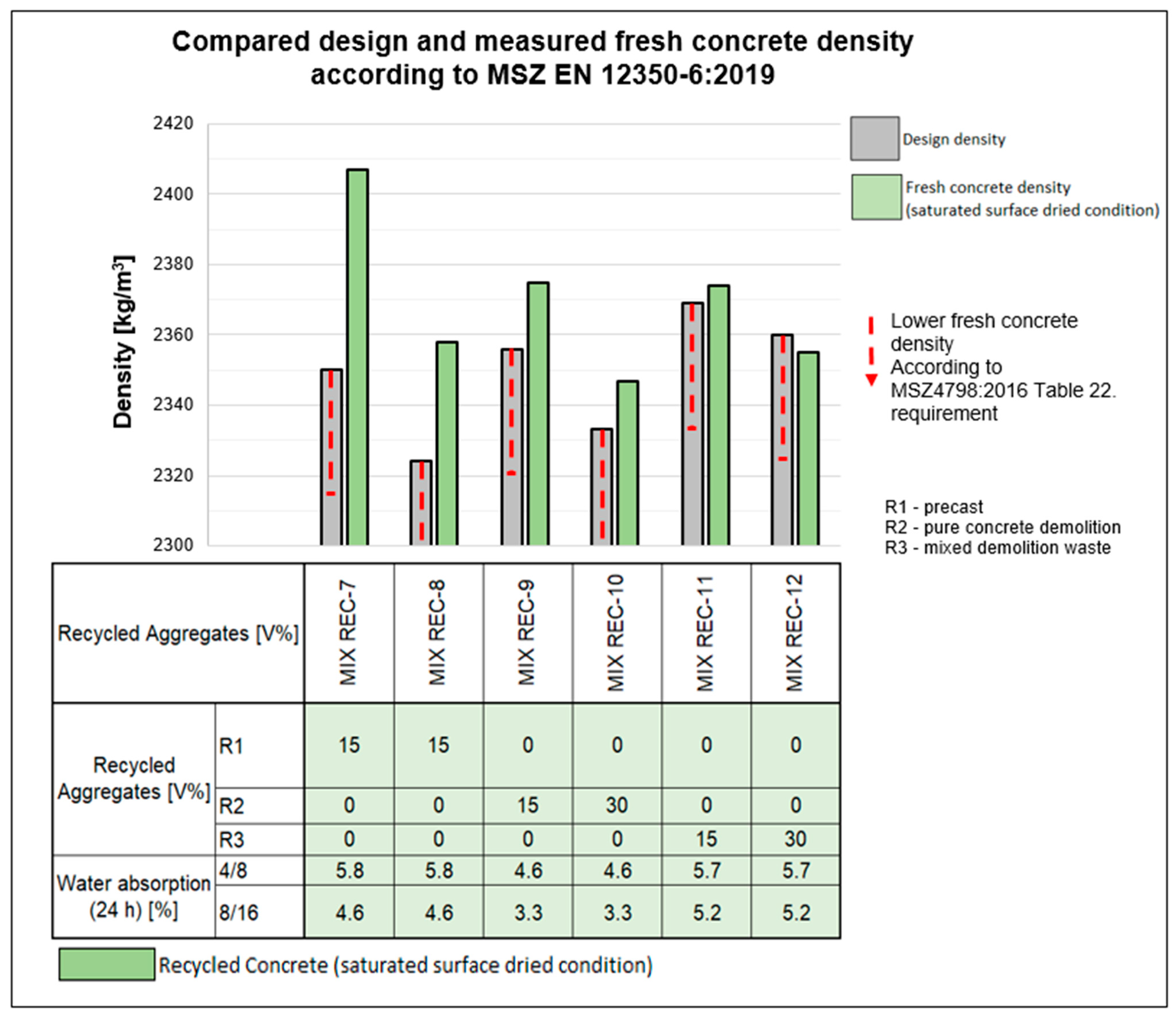
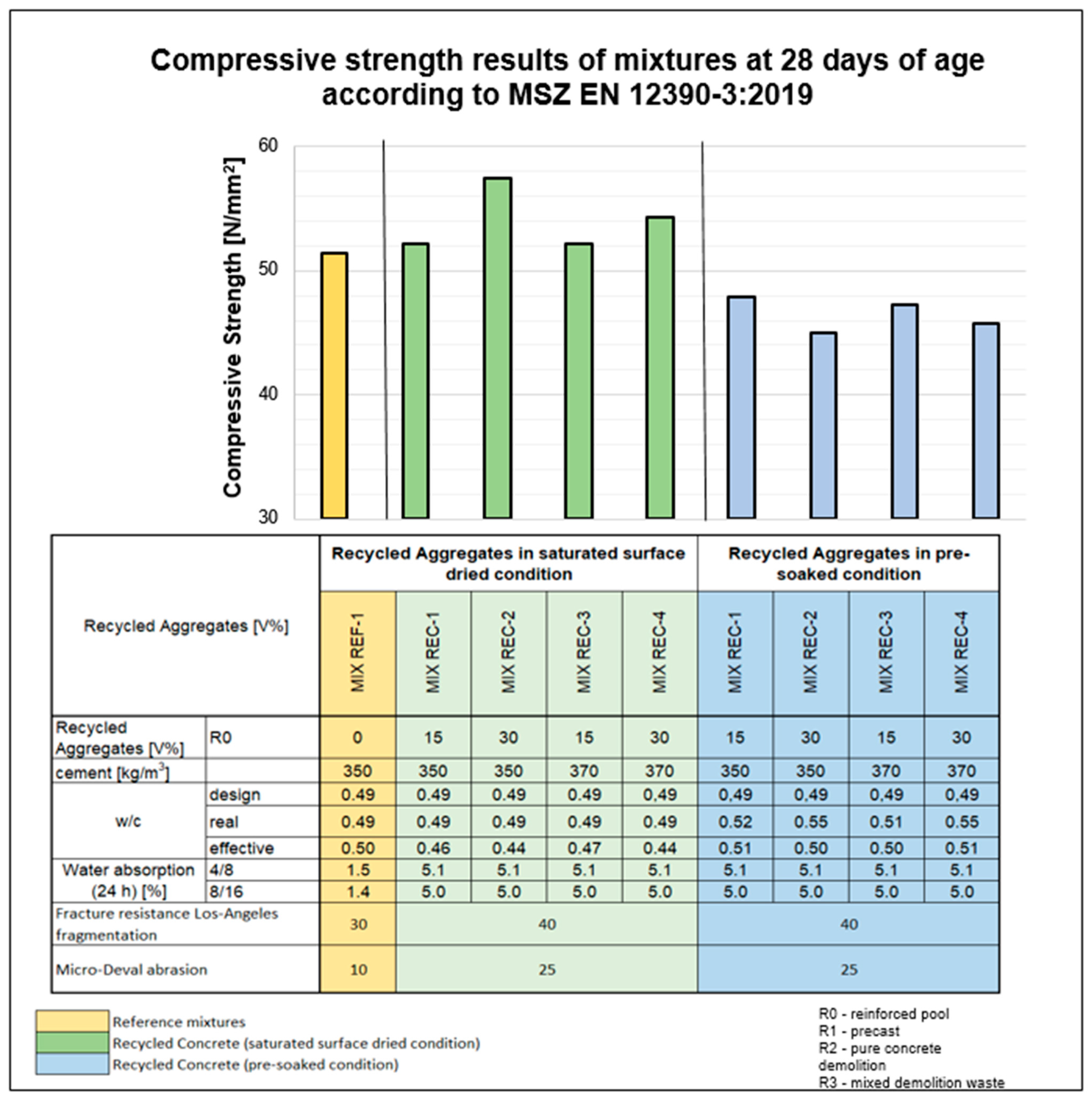
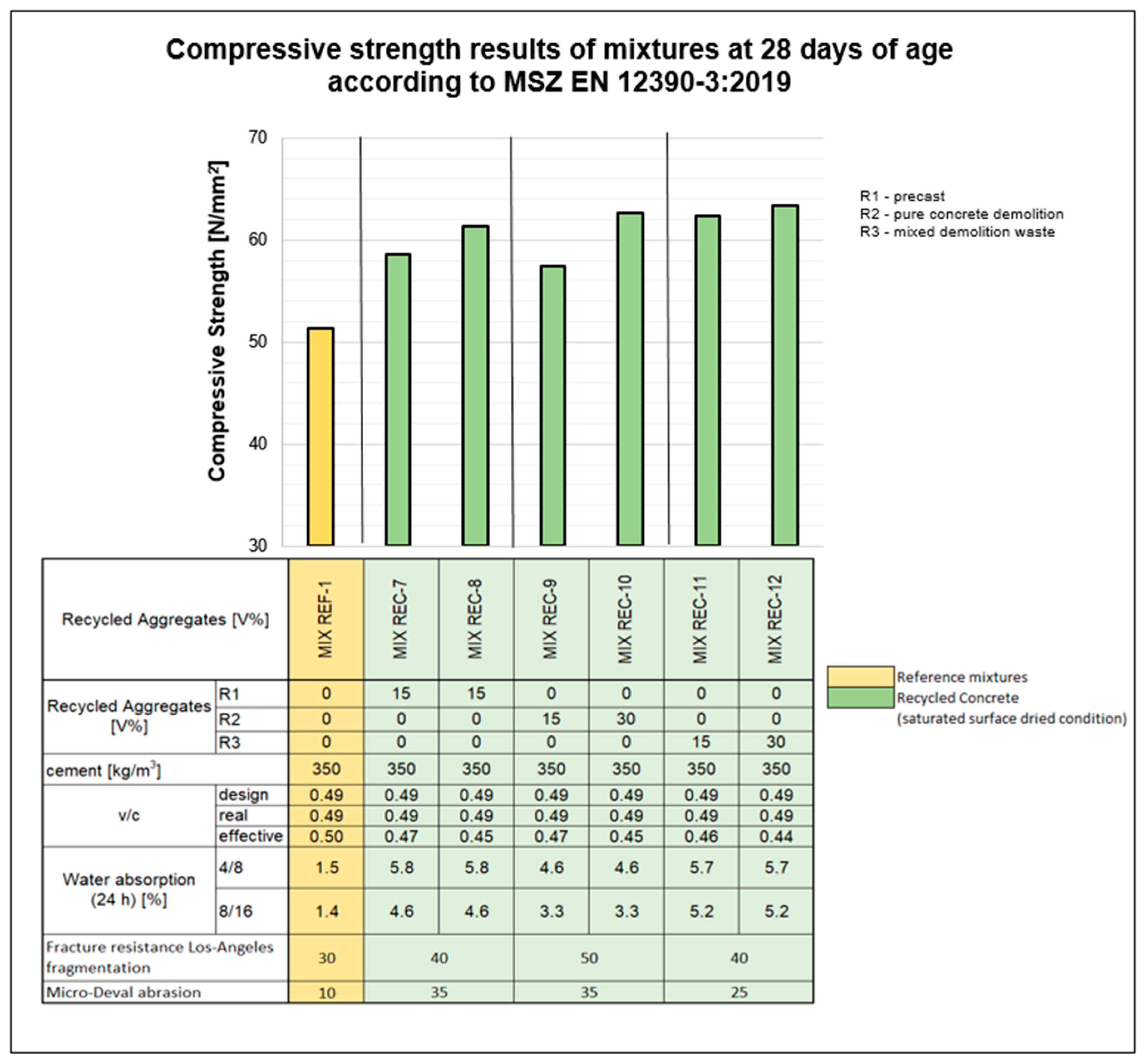
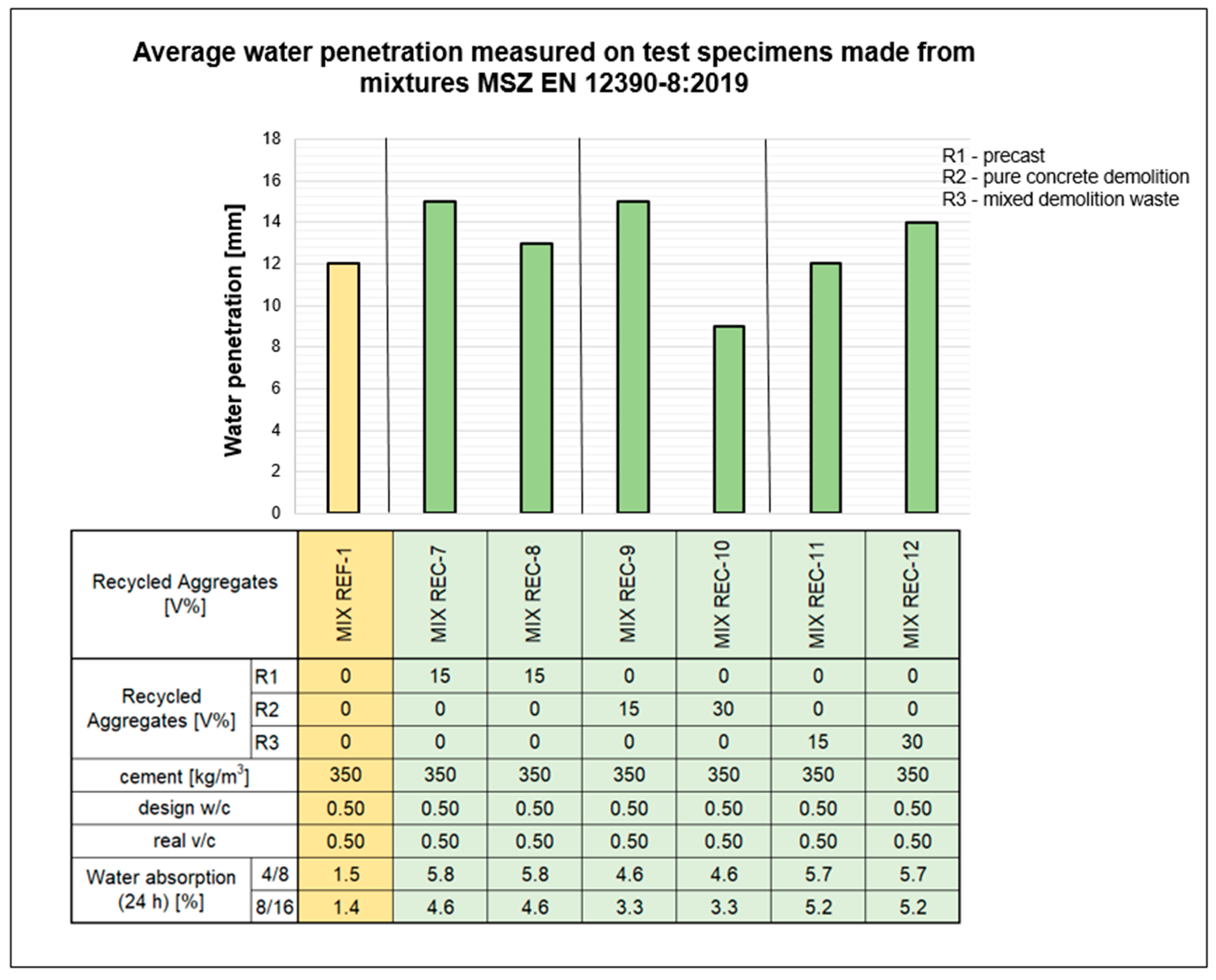
| Reference | RCA Content (%) | Key Findings on Compressive Strength | Type of RCA Used | Compressive Strength Class (MPa) | Additional Notes |
|---|---|---|---|---|---|
| Fong et al. [1,2] | 30% | Demonstrated feasibility of using RAC for structural applications | Crushed concrete | 30–40 | Used in Hong Kong infrastructure projects |
| Lim et al. [3] | 50% | Reduced workability, lower strength | Mixed RCA | 45–52 | - |
| Ramakrishnaiah et al. [4] | Investigated effects of polypropylene fibers on geopolymer concrete strength | Fly ash-based recycled aggregate | 25–35 | Enhanced flexural strength observed | |
| Ismail and Ramli [5,6] | 30% | Pre-treatment improved strength | Pre-treated RCA | 43–47 | Acid treatment applied |
| Tiznobaik et al. [7] | 30% | Found that RCA can achieve C20/25 and C30/37 strength classes | Crushed demolition waste | 25–37 | Long-term durability assessed |
| Zhang et al. [8] | 20% | Studied surface modifications to improve compressive strength | Coarse recycled aggregates | 35–45 | Modified surfaces improved bond strength. Comparable to natural aggregate concrete. |
| Ju et al. [9] | 50% | Strength reduction due to higher porosity | Mixed RCA | 35 | - |
| Sampaio et al. [10] | 35% | Evaluated RAC in high-performance concrete (C50/60) | Mixed recycled aggregates | 50–60 | Suitable for structural applications |
| Robalo et al. [11] | 20% | Strength enhancement with specific additives | Recycled coarse aggregates | 50 | Additives improved bonding |
| Reference | RCA Content (%) | Findings on Setting Time | Type of RCA Used | Initial Setting Time (min) | Final Setting Time (min) |
|---|---|---|---|---|---|
| Ismail & Ramli [5,6] | 30% | Surface treatment with acid improved setting time consistency | Acid-treated RCA | 45 | 120 |
| Aili et al. [12] | 30% | Reported that higher porosity in RCA led to increased setting time variability | Untreated RCA | 60 | 150 |
| García-González et al. [13] | 30% | Pre-saturation technique enhanced workability but slightly increased setting time | Pre-saturated RCA | 50 | 130 |
| Ju et al. [9] | 50% | CO2 curing accelerated setting time improvements | Carbonated RCA | 40 | 110 |
| Wang et al. [14] | 35% | Developed a numerical model for setting time estimation in RAC | Various recycled aggregates | 55 | 140 |
| Babraddin et al. [15] | 40% | Higher RCA led to shorter setting time | Mixed RCA | 32 | 110 |
| Reference | RCA Content (%) | Key Findings on Impermeability | Type of RCA Used | Water Penetration Depth (mm) | Additional Notes |
|---|---|---|---|---|---|
| Ahmad SI [16] | 30% | Found that RAC had significantly higher permeability (225–550%) than NAC | Crushed clay brick as coarse aggregate | 15–35 | Increased porosity reduced resistance |
| Robalo et al. [11] | 30% | Reported that RCA increases porosity and water absorption | High-paste RCA | 20–40 | High absorption affected durability |
| Skocek et al. [17] | 40% | Developed a method to reduce RCA porosity through controlled separation | Recycled sand and coarse aggregates | 10–25 | Improved compaction reduced voids |
| Al-Kheetan et al. [18] | 50% | Use of nano-ZnO improved impermeability and reduced pore size | Nano-particle-treated RCA | 8–20 | Nano-modifications reduced permeability |
| Zhong et al. [19] | 20% | Evaluated water absorption changes due to freeze-thaw cycles in RAC | Freeze–thaw modified RCA | 12–30 | Variable results based on exposure conditions |
| Concrete Mix Code | Coarse Aggregate | ||
|---|---|---|---|
| Natural | Recycled | Recycled Material Source | |
| MIX REF-1 | 100% | 0% | |
| MIX REC-1 (15) | 85% | 15% | reinforced pool: R0 |
| MIX REC-2 (30) | 70% | 30% | reinforced pool: R0 |
| MIX REC-3 (15 m) | 85% | 15% | reinforced pool: R0 |
| MIX REC-4 (30 m) | 70% | 30% | reinforced pool: R0 |
| MIX REC-7 (15) | 85% | 15% | precast: R1 |
| MIX REC-8 (30) | 70% | 30% | precast: R1 |
| MIX REC-9 (15) | 85% | 15% | pure concrete demolition: R2 |
| MIX REC-10 (30) | 70% | 30% | pure concrete demolition: R2 |
| MIX REC-11 (15) | 85% | 15% | mixed demolition waste: R3 |
| MIX REC-12 (30) | 70% | 30% | mixed demolition waste: R3 |
| Concrete Mix Code | Cement [kg] | Water [kg] | W/C | Sand 0/4 [kg] | Coarse Aggregate [kg/m3] | Admixture [mc%] | Design Density [kg/m3] | ||||||
|---|---|---|---|---|---|---|---|---|---|---|---|---|---|
| NA 4/8; 8/16 | RAC 4/8; 8/16 | Admixture 1 | Admixture 2 | Admixture 3 | |||||||||
| N | R0 | R1 | R2 | R3 | |||||||||
| MIX REF-1 | 350 | 170 | 0.49 | 744 | 1116 | 0 | 0 | 0 | 0 | 0.70 | 2383 | ||
| MIX REC-1 (15) | 350 | 170 | 0.49 | 742 | 944 | 167 | 0 | 0 | 0 | 0.50 | 2378 | ||
| MIX REC-2 (30) | 350 | 170 | 0.49 | 742 | 774 | 335 | 0 | 0 | 0 | 0.50 | 2375 | ||
| MIX REC-3 (15 m) | 370 | 180 | 0.49 | 761 | 892 | 157 | 0 | 0 | 0 | 0.50 | 2365 | ||
| MIX REC-4 (30 m) | 370 | 180 | 0.49 | 760 | 731 | 103 | 0 | 0 | 0 | 0.55 | 2360 | ||
| MIX REC-7 (15) | 350 | 170 | 0.49 | 741 | 949 | 0 | 137 | 0 | 0 | 0.45 | 0.70 | 2350 | |
| MIX REC-8 (30) | 350 | 170 | 0.49 | 739 | 783 | 0 | 275 | 0 | 0 | 0.70 | 1.00 | 2324 | |
| MIX REC-9 (15) | 350 | 170 | 0.49 | 741 | 949 | 0 | 0 | 142 | 0 | 0.45 | 0.65 | 2356 | |
| MIX REC-10 (30) | 350 | 170 | 0.49 | 740 | 781 | 0 | 0 | 287 | 0 | 0.70 | 0.85 | 2333 | |
| MIX REC-11 (15) | 350 | 170 | 0.49 | 740 | 947 | 0 | 0 | 0 | 156 | 0.60 | 0.85 | 2369 | |
| MIX REC-12 (30) | 350 | 170 | 0.49 | 739 | 779 | 0 | 0 | 0 | 316 | 0.85 | 1.10 | 2360 | |
| Natural/Recycled Aggregates Size [mm] | Water Absorption (24 h) [%] | Los Angeles | Micro-Deval | Density [Mg/m3] |
|---|---|---|---|---|
| Standard | EN 1097-6 | EN 1097-2 | EN 1097-1 | EN 1097-6 |
| 4/8 | ||||
| NA | 1.5 | 2.63 | ||
| R0 | 5.1 | 2.63 | ||
| R1 | 5.8 | 2.18 | ||
| R2 | 4.6 | 2.28 | ||
| R3 | 5.7 | 2.54 | ||
| 8/16 | ||||
| NA | 1.4 | 2.68 | ||
| R0 | 5.0 | 2.58 | ||
| R1 | 4.6 | 2.22 | ||
| R2 | 3.3 | 2.31 | ||
| R3 | 5.2 | 2.52 | ||
| NA | <30 | <10 | ||
| R0 | 39 | 27 | ||
| R1 | 39 | 22 | ||
| R2 | 41 | 31 | ||
| R3 | 38 | 24 |
Disclaimer/Publisher’s Note: The statements, opinions and data contained in all publications are solely those of the individual author(s) and contributor(s) and not of MDPI and/or the editor(s). MDPI and/or the editor(s) disclaim responsibility for any injury to people or property resulting from any ideas, methods, instructions or products referred to in the content. |
© 2025 by the authors. Licensee MDPI, Basel, Switzerland. This article is an open access article distributed under the terms and conditions of the Creative Commons Attribution (CC BY) license (https://creativecommons.org/licenses/by/4.0/).
Share and Cite
Banyai, K.; Czoboly, O.; Menyhart, K.; Orban, Z. Influence of Aggregate Composition on the Properties of Recycled Concrete and Improving Performance Using Special Additives. Materials 2025, 18, 1108. https://doi.org/10.3390/ma18051108
Banyai K, Czoboly O, Menyhart K, Orban Z. Influence of Aggregate Composition on the Properties of Recycled Concrete and Improving Performance Using Special Additives. Materials. 2025; 18(5):1108. https://doi.org/10.3390/ma18051108
Chicago/Turabian StyleBanyai, Kitti, Oliver Czoboly, Krisztian Menyhart, and Zoltan Orban. 2025. "Influence of Aggregate Composition on the Properties of Recycled Concrete and Improving Performance Using Special Additives" Materials 18, no. 5: 1108. https://doi.org/10.3390/ma18051108
APA StyleBanyai, K., Czoboly, O., Menyhart, K., & Orban, Z. (2025). Influence of Aggregate Composition on the Properties of Recycled Concrete and Improving Performance Using Special Additives. Materials, 18(5), 1108. https://doi.org/10.3390/ma18051108







